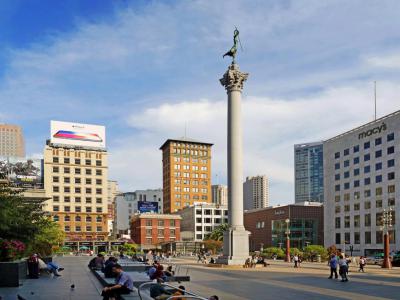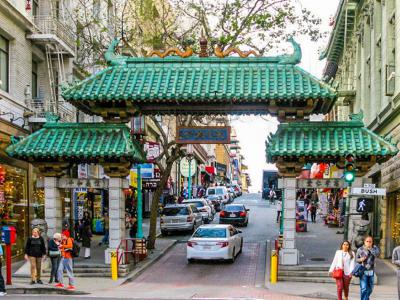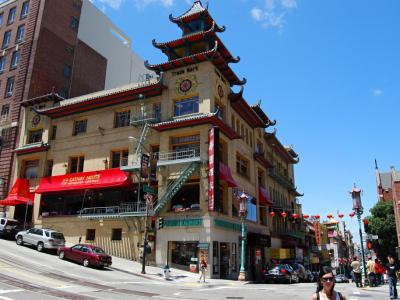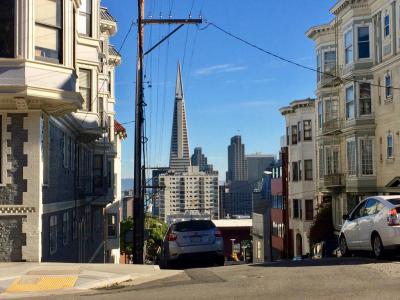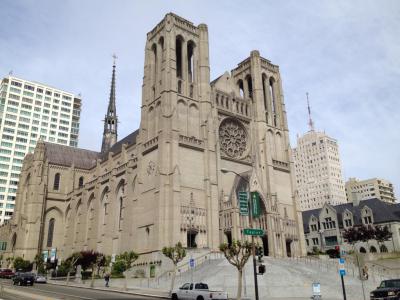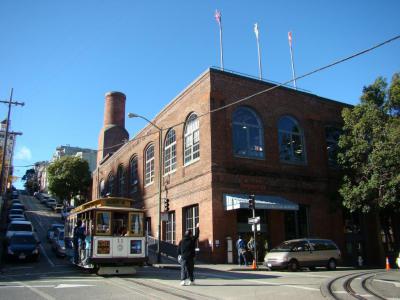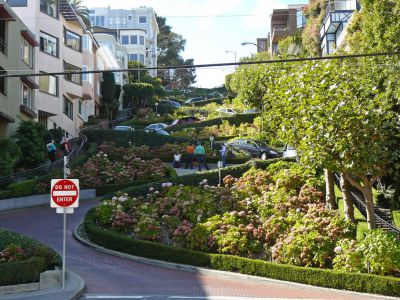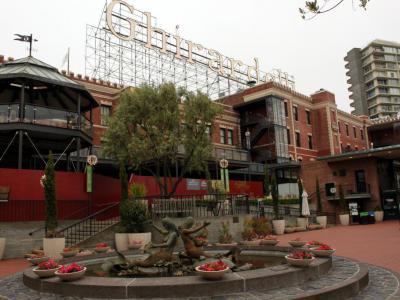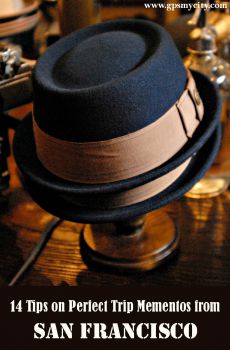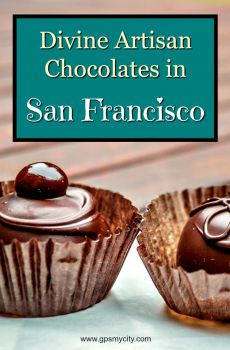Audio Guide: San Francisco Introduction Walking Tour (Self Guided), San Francisco
A commercial and cultural hub of northern California, San Francisco is a popular tourist destination known for its steep rolling hills and eclectic mix of world-famous landmarks. The iconic Golden Gate Bridge, the teeth-rattling cable cars carrying riders up and down Nob Hill, Alcatraz Island, and the oldest Chinatown in North America are just some of the city's prominent attractions, each contributing to its unique flavor.
The original settlement of today's San Francisco emerged in 1776 when a group of Spanish colonists established a fortress (near the present Golden Gate) and a mission (a few miles away) both named after Saint Francis of Assisi. In 1821, the Spaniards passed the territory to the Mexicans, who in turn ceded it to the United States in 1848. The California Gold Rush of 1849 brought rapid growth to the area, transforming San Francisco from an unimportant hamlet to a busy port. By 1901, it had become a major city, largest on the West Coast, known for its flamboyant style, stately hotels, ostentatious mansions, and a thriving arts scene.
After the destructive earthquake of 1906, the city was quickly rebuilt, and on a grand scale too, seeing, among other achievements, the construction of the streetcar system. At the height of the Great Depression of the 1930s, San Francisco undertook great civil engineering projects, including the Golden Gate Bridge completed in 1937.
After World War II, the city hosted the birth of the United Nations in 1945. It was the ground for the rise of the "beatnik" and "hippie" cultures in the 1950s and 60s. The Sexual Revolution, the Peace Movement (following the Vietnam War), the Summer of Love of 1967, and the gay rights movement of the 1970s asserted San Francisco as a center of liberal activism in the United States. More recently, the dot-com boom of the late 1990s, driven by the Internet industry, further invigorated the city's economy.
Still, tourism is one of San Francisco's major industries fueled by attractions like Lombard Street (known for its "crookedness"), Pier 39 (with its colony of sunbathing sea lions), the Aquarium of the Bay, and others. The historic heart of the city is centered on Union Square, the principal shopping and hotel district.
Whatever your idea of a dream trip to San Francisco is, take this self-guided walking tour as a valuable companion and brave the city on foot with GPSmyCity without fear of getting lost!
The original settlement of today's San Francisco emerged in 1776 when a group of Spanish colonists established a fortress (near the present Golden Gate) and a mission (a few miles away) both named after Saint Francis of Assisi. In 1821, the Spaniards passed the territory to the Mexicans, who in turn ceded it to the United States in 1848. The California Gold Rush of 1849 brought rapid growth to the area, transforming San Francisco from an unimportant hamlet to a busy port. By 1901, it had become a major city, largest on the West Coast, known for its flamboyant style, stately hotels, ostentatious mansions, and a thriving arts scene.
After the destructive earthquake of 1906, the city was quickly rebuilt, and on a grand scale too, seeing, among other achievements, the construction of the streetcar system. At the height of the Great Depression of the 1930s, San Francisco undertook great civil engineering projects, including the Golden Gate Bridge completed in 1937.
After World War II, the city hosted the birth of the United Nations in 1945. It was the ground for the rise of the "beatnik" and "hippie" cultures in the 1950s and 60s. The Sexual Revolution, the Peace Movement (following the Vietnam War), the Summer of Love of 1967, and the gay rights movement of the 1970s asserted San Francisco as a center of liberal activism in the United States. More recently, the dot-com boom of the late 1990s, driven by the Internet industry, further invigorated the city's economy.
Still, tourism is one of San Francisco's major industries fueled by attractions like Lombard Street (known for its "crookedness"), Pier 39 (with its colony of sunbathing sea lions), the Aquarium of the Bay, and others. The historic heart of the city is centered on Union Square, the principal shopping and hotel district.
Whatever your idea of a dream trip to San Francisco is, take this self-guided walking tour as a valuable companion and brave the city on foot with GPSmyCity without fear of getting lost!
How it works: Download the app "GPSmyCity: Walks in 1K+ Cities" from Apple App Store or Google Play Store to your mobile phone or tablet. The app turns your mobile device into a personal tour guide and its built-in GPS navigation functions guide you from one tour stop to next. The app works offline, so no data plan is needed when traveling abroad.
San Francisco Introduction Walking Tour Map
Guide Name: San Francisco Introduction Walking Tour
Guide Location: USA » San Francisco (See other walking tours in San Francisco)
Guide Type: Self-guided Walking Tour (Sightseeing)
# of Attractions: 9
Tour Duration: 3 Hour(s)
Travel Distance: 5.3 Km or 3.3 Miles
Author: doris
Sight(s) Featured in This Guide:
Guide Location: USA » San Francisco (See other walking tours in San Francisco)
Guide Type: Self-guided Walking Tour (Sightseeing)
# of Attractions: 9
Tour Duration: 3 Hour(s)
Travel Distance: 5.3 Km or 3.3 Miles
Author: doris
Sight(s) Featured in This Guide:
- Union Square
- Chinatown Gate (Dragon's Gate)
- Sing Chong Building
- Nob Hill
- Grace Cathedral
- Cable Car Museum
- Lombard Street
- Ghirardelli Square
- Pier 39
1) Union Square (must see)
While there are lots of tourist sights in San Francisco to behold, there is none more representative of the city's spirit than the iconic Union Square. With so many layers of history, cuisine, commerce, and culture gathered in one spot, it is no wonder that this place has appeared in film and television scores of times over the years! One could teach a master class on the goings on at Union Square through the decades.
Starting from the pro-US rallies during the Civil War (hence the "Union" name) to the red-light district on (ironically) Maiden Lane, the Dewey Monument, and Alma Spreckels, the Saint Francis Hotel and its famous guests, the 1960s protests, the Theater District, the Powell cable car line, the Flood Building, and the Woolworth's counter – the list is long. Add to this the rooftop amusement park, the concerts, the window displays, and key appearances in famous movies – and you get the place that is quintessentially San Francisco in much of the same way as Times Square is for New York City.
Nowadays, the square is known as a sanctuary for the shopaholic at heart, ringed by premium boutiques, high-end department stores, and mega-brands – but also as one of maybe two places in the city where you can go ice-skating outdoors during the winter.
If you're looking for the best cheap eats, consider Sear's Fine Food or the Pinecrest Diner. For mid-range – there's Cheesecake Factory with a spectacular view of the square and the unforgettable Rotunda at Neiman Marcus. And if you want to go posh, there are too many choices, but Scala's Bistro at the Sir Francis Drake Hotel is ideal; also, The Oak Room, if you have the means.
Finally, no tour of Union Square is complete without visiting the venerable Hotel Saint Francis, where kings, presidents, movie stars, and other historical figures from every field have stayed. In its grand lobby stands an antique clock, and the phrase "Meet me at the clock" is known to most San Franciscans. During holidays, the hotel is decked out in festive décor, with a giant chocolate castle diorama to salivate over. It feels like stepping into a bygone era of luxury and superb service.
Given the range of delights available at Union Square (stores, restaurants, theaters, as well as the famous cable cars), it is safe to say it is at the heart of it all and makes a logical starting point for the exploration of San Francisco.
Tip:
Take the Powell/Hyde cable car ride (which starts and ends at Union Square) for the best views of the city. And don't mind the line if there is one – it can move quickly.
Starting from the pro-US rallies during the Civil War (hence the "Union" name) to the red-light district on (ironically) Maiden Lane, the Dewey Monument, and Alma Spreckels, the Saint Francis Hotel and its famous guests, the 1960s protests, the Theater District, the Powell cable car line, the Flood Building, and the Woolworth's counter – the list is long. Add to this the rooftop amusement park, the concerts, the window displays, and key appearances in famous movies – and you get the place that is quintessentially San Francisco in much of the same way as Times Square is for New York City.
Nowadays, the square is known as a sanctuary for the shopaholic at heart, ringed by premium boutiques, high-end department stores, and mega-brands – but also as one of maybe two places in the city where you can go ice-skating outdoors during the winter.
If you're looking for the best cheap eats, consider Sear's Fine Food or the Pinecrest Diner. For mid-range – there's Cheesecake Factory with a spectacular view of the square and the unforgettable Rotunda at Neiman Marcus. And if you want to go posh, there are too many choices, but Scala's Bistro at the Sir Francis Drake Hotel is ideal; also, The Oak Room, if you have the means.
Finally, no tour of Union Square is complete without visiting the venerable Hotel Saint Francis, where kings, presidents, movie stars, and other historical figures from every field have stayed. In its grand lobby stands an antique clock, and the phrase "Meet me at the clock" is known to most San Franciscans. During holidays, the hotel is decked out in festive décor, with a giant chocolate castle diorama to salivate over. It feels like stepping into a bygone era of luxury and superb service.
Given the range of delights available at Union Square (stores, restaurants, theaters, as well as the famous cable cars), it is safe to say it is at the heart of it all and makes a logical starting point for the exploration of San Francisco.
Tip:
Take the Powell/Hyde cable car ride (which starts and ends at Union Square) for the best views of the city. And don't mind the line if there is one – it can move quickly.
2) Chinatown Gate (Dragon's Gate)
In keeping with Feng Shui principles, the southern edge of San Francisco’s Chinatown is marked by a towering gateway that straddles the bustle of Grant Avenue. This is the Dragon Gate, a flamboyant arch dressed in curling green dragons and traditional tiles. It might look timeless, but it’s actually a relative newcomer-unveiled only in 1970. Its materials were a gift from Taiwan, while the elegant design came from Chinese-American architect Clayton Lee, who modeled it after the ceremonial village gates of old China. Across the top, four carved Chinese characters proclaim a message of welcome: “All under heaven is for the good of the people.”
Guarding the arch are a pair of stone lions, known as fu dogs. On the west side, the male lion steadies a ball beneath his paw, symbolizing protection of the outside world. On the east, the lioness rests her paw on a playful cub, representing the nurturing of family. Together, they embody the balance of strength and care, ensuring that any evil spirits think twice before crossing the threshold.
Pass beneath the gate, and the character of the neighborhood unfolds in full color. In the 1920s, local merchants reinvented Chinatown’s appearance by adding pagoda-roofed façades and bright ornamental details-a pioneering initiative which created an identity that has drawn visitors ever since. The once-notorious red-light district gave way to lantern-strung streets. As evening sets in, the dragon-shaped streetlights flicker on, casting a warm glow across the lively thoroughfare, bustling with herbal shops, bakeries, tea houses, and jewelry stores.
Guarding the arch are a pair of stone lions, known as fu dogs. On the west side, the male lion steadies a ball beneath his paw, symbolizing protection of the outside world. On the east, the lioness rests her paw on a playful cub, representing the nurturing of family. Together, they embody the balance of strength and care, ensuring that any evil spirits think twice before crossing the threshold.
Pass beneath the gate, and the character of the neighborhood unfolds in full color. In the 1920s, local merchants reinvented Chinatown’s appearance by adding pagoda-roofed façades and bright ornamental details-a pioneering initiative which created an identity that has drawn visitors ever since. The once-notorious red-light district gave way to lantern-strung streets. As evening sets in, the dragon-shaped streetlights flicker on, casting a warm glow across the lively thoroughfare, bustling with herbal shops, bakeries, tea houses, and jewelry stores.
3) Sing Chong Building
After the devastating earthquake of 1906 left much of San Francisco in ruins, city officials toyed with the idea of relocating the Chinese community to a far-off district (now known as Bayview). But the residents of Chinatown, backed by the Chinese Consulate and a network of family associations, stood their ground. Their refusal to budge would set the stage for a remarkable rebirth.
A group of like-minded merchants led by Look Tin Eli, an influential businessman born in Mendocino to Chinese immigrants, came up with a bold and rather clever marketing idea: to rebuild the entire community as a tourist destination rather than a hidden quarter.
To achieve that, they hired American (non-Chinese) architects and contractors, asking them to design storefronts and halls in a theatrical version of traditional Chinese style-complete with sweeping roofs, pagoda towers, and brightly painted façades that would catch the eye while celebrating cultural pride. Indeed, this was more than decoration but a way to claim space in the heart of a city that once tried to push them out.
Soon, the fruits of their vision appeared in the form of two landmarks, the ornate bazaars of Sing Chong and Sing Fat. These structures were among the first to rise after the disaster, instantly signaling that Chinatown was here to stay. Their distinctive design, featuring the now-famous pagoda rooftops and carved balconies, caught the city’s imagination and inspired other buildings to follow suit, giving the district its vibrant, instantly recognizable look it retains today.
One of the buildings embracing the trend was the Bank of America at 701 Grant Avenue. Previously occupied by the Nanking Fook Wo Inc., it had adopted Chinese dragon motifs along the façade, echoing the new visual identity of the area. What began as a response to the disaster transformed into an architectural statement, one that still defines the character of San Francisco’s most storied neighborhood now.
A group of like-minded merchants led by Look Tin Eli, an influential businessman born in Mendocino to Chinese immigrants, came up with a bold and rather clever marketing idea: to rebuild the entire community as a tourist destination rather than a hidden quarter.
To achieve that, they hired American (non-Chinese) architects and contractors, asking them to design storefronts and halls in a theatrical version of traditional Chinese style-complete with sweeping roofs, pagoda towers, and brightly painted façades that would catch the eye while celebrating cultural pride. Indeed, this was more than decoration but a way to claim space in the heart of a city that once tried to push them out.
Soon, the fruits of their vision appeared in the form of two landmarks, the ornate bazaars of Sing Chong and Sing Fat. These structures were among the first to rise after the disaster, instantly signaling that Chinatown was here to stay. Their distinctive design, featuring the now-famous pagoda rooftops and carved balconies, caught the city’s imagination and inspired other buildings to follow suit, giving the district its vibrant, instantly recognizable look it retains today.
One of the buildings embracing the trend was the Bank of America at 701 Grant Avenue. Previously occupied by the Nanking Fook Wo Inc., it had adopted Chinese dragon motifs along the façade, echoing the new visual identity of the area. What began as a response to the disaster transformed into an architectural statement, one that still defines the character of San Francisco’s most storied neighborhood now.
4) Nob Hill
The embodiment of "swank" in San Francisco's history, Nob Hill is perched on a hilltop above Union Square and Chinatown. The neighborhood elegantly preserves some of the character brought to it by the early railroad and financial barons who built their mansions here.
One of the prime reasons why Nob Hill attracted (and still does) affluent classes is its centralized location. Over the years, it was once home to some of the most prominent names in America's political and business history, including Leyland Stanford (governor of California and US Senator in the late 1800s), Collins Huntington (19th-century industrialist and railway magnate), as well as Mark Hopkins and Charles Crocker, founders of the Central Pacific Railroad. Strolling the area, you can get a glimpse of their grand mansions poised with majestic galore atop the Hill.
After the 1906 earthquake and ensuing fire, some mansions were revamped into luxury hotels. The most expensive of them, such as Fairmont, Hopkins, Stanford Court, or Huntington, stand literally on the ruins of the 1906 disaster.
Presently, the neighborhood attracts thousands of visitors each year, who either walk all the way up (if fit) or drive or take a cable car to wander around, see the architecture, and, perhaps, stroll occasionally into the Fairmont Hotel lobby for a drink. You can also admire the scenery at the Top of the Mark in the Mark Hopkins Hotel, have lunch or dinner at one of the several local restaurants, or enjoy a peaceful interlude in the beautiful Grace Cathedral. There is also pleasant Huntington Park with the Tortoise Fountain worth checking out, where you can sit, stretch your weary feet and relax.
One of the prime reasons why Nob Hill attracted (and still does) affluent classes is its centralized location. Over the years, it was once home to some of the most prominent names in America's political and business history, including Leyland Stanford (governor of California and US Senator in the late 1800s), Collins Huntington (19th-century industrialist and railway magnate), as well as Mark Hopkins and Charles Crocker, founders of the Central Pacific Railroad. Strolling the area, you can get a glimpse of their grand mansions poised with majestic galore atop the Hill.
After the 1906 earthquake and ensuing fire, some mansions were revamped into luxury hotels. The most expensive of them, such as Fairmont, Hopkins, Stanford Court, or Huntington, stand literally on the ruins of the 1906 disaster.
Presently, the neighborhood attracts thousands of visitors each year, who either walk all the way up (if fit) or drive or take a cable car to wander around, see the architecture, and, perhaps, stroll occasionally into the Fairmont Hotel lobby for a drink. You can also admire the scenery at the Top of the Mark in the Mark Hopkins Hotel, have lunch or dinner at one of the several local restaurants, or enjoy a peaceful interlude in the beautiful Grace Cathedral. There is also pleasant Huntington Park with the Tortoise Fountain worth checking out, where you can sit, stretch your weary feet and relax.
5) Grace Cathedral (must see)
Sitting atop the commanding height of Nob Hill, the Grace Cathedral is one of the biggest hunks of Neo-Gothic architecture in the U.S.
This church has been rebuilt at least three times since the Gold Rush. Its current Notre-Dame-inspired, reinforced-concrete structure took four decades to complete. The lengthy gestation period partly explains the certain hodge-podge aspects of the design. The faithful replicas of Ghiberti's famed bronze Florence Baptistery doors adorning the main entrance seem rather unexpected.
Inside, there are some clever effects with natural lighting, suggesting a traditional – and thus remarkably European – Gothic atmosphere (which gets particularly gorgeous on sunny evenings) with an uninterrupted view up to the high altar. As you go in, you will immediately encounter a second labyrinth (the first one is right near the entrance) whose patterns are capable of bringing wanderers to the state of meditation. Also of note are the works of Jan Henryk De Rosen, seen in the aisle, including an altarpiece in the Chapel of Grace and a mural in the Chapel of Nativity's Adoration.
Another welcome plus are the cute restrooms downstairs, a coffee bar, and a small souvenir shop. If you're looking for a peaceful respite in this otherwise "upscale desert" for tourists, enhanced with many works of art, this church is the place. Outside the Cathedral, there are arguably two most opulent and expensive hotels in San Francisco and a small park out front, affording an impressive panoramic view.
The temple is open Monday through Friday, from 7am to 6pm; Saturday, from 8am to 6pm; and Sunday, from 8am to 7pm.
Tip:
If you choose to walk up the hill, getting here is a real climb, but the California Street Cable Car can always bring you up – no problem – should you wish to do so.
This church has been rebuilt at least three times since the Gold Rush. Its current Notre-Dame-inspired, reinforced-concrete structure took four decades to complete. The lengthy gestation period partly explains the certain hodge-podge aspects of the design. The faithful replicas of Ghiberti's famed bronze Florence Baptistery doors adorning the main entrance seem rather unexpected.
Inside, there are some clever effects with natural lighting, suggesting a traditional – and thus remarkably European – Gothic atmosphere (which gets particularly gorgeous on sunny evenings) with an uninterrupted view up to the high altar. As you go in, you will immediately encounter a second labyrinth (the first one is right near the entrance) whose patterns are capable of bringing wanderers to the state of meditation. Also of note are the works of Jan Henryk De Rosen, seen in the aisle, including an altarpiece in the Chapel of Grace and a mural in the Chapel of Nativity's Adoration.
Another welcome plus are the cute restrooms downstairs, a coffee bar, and a small souvenir shop. If you're looking for a peaceful respite in this otherwise "upscale desert" for tourists, enhanced with many works of art, this church is the place. Outside the Cathedral, there are arguably two most opulent and expensive hotels in San Francisco and a small park out front, affording an impressive panoramic view.
The temple is open Monday through Friday, from 7am to 6pm; Saturday, from 8am to 6pm; and Sunday, from 8am to 7pm.
Tip:
If you choose to walk up the hill, getting here is a real climb, but the California Street Cable Car can always bring you up – no problem – should you wish to do so.
6) Cable Car Museum (must see)
When it comes to public transportation in the City by the Bay, cable cars steal the show! Invented in the late 19th century, they were introduced on an experimental basis for the uneven and steep terrain of San Francisco. After nearly two centuries, these cars have not only proven vital for everyday commute, whirring through the streets from 6 am to 1 am, but also become its identity card.
It is, therefore, only natural to expect them to be celebrated with a designated museum. Such a place does exist and is more than just a museum but is also a showcase of the inner workings of San Francisco's cable car network. The hub of four main cable systems, all the existing cable lines are routed from this building, allowing visitors to view them from the top floor.
You can spend a good one hour in the museum, looking around the well-spaced exhibits accompanied with quite a bit of information. Another incentive to visit is the free admission!
They have a donation box for those who care to contribute. Cable cars are expensive to maintain, and supporting the museum financially, much as taking a ride in one of the cars can help keep the system running.
There is also a cute gift shop with souvenirs, plus a great café across the road, for afterward.
Tip:
If you visit the museum on one of your first days, you will look at the cars in the street with more knowledge for the rest of your vacation.
The museum is open daily: from 10am to 6pm (April through September); and from 10am to 5pm (November through March).
It is, therefore, only natural to expect them to be celebrated with a designated museum. Such a place does exist and is more than just a museum but is also a showcase of the inner workings of San Francisco's cable car network. The hub of four main cable systems, all the existing cable lines are routed from this building, allowing visitors to view them from the top floor.
You can spend a good one hour in the museum, looking around the well-spaced exhibits accompanied with quite a bit of information. Another incentive to visit is the free admission!
They have a donation box for those who care to contribute. Cable cars are expensive to maintain, and supporting the museum financially, much as taking a ride in one of the cars can help keep the system running.
There is also a cute gift shop with souvenirs, plus a great café across the road, for afterward.
Tip:
If you visit the museum on one of your first days, you will look at the cars in the street with more knowledge for the rest of your vacation.
The museum is open daily: from 10am to 6pm (April through September); and from 10am to 5pm (November through March).
7) Lombard Street (must see)
As a tourist magnet, Lombard Street is recognized as the most crooked street in the world. It takes eight turns on a 24-degree slope to make one feel that it is also, indeed, one of the steepest.
Even though walking or cycling this one-way (downhill) street may instill a sense of immediate vertigo, which can be risky at times, the reason for Lombard's crooked form, surprisingly, is safety. Given the natural grading of the land, the zig-zag pattern reduces the effect of the slope's steepness, making it easier to play on. As far back as 1920, it was suggested that scenic switchbacks to be added to bring a certain appeal to the surroundings, and apparently, it worked.
Year after year, Lombard Street manages to get more than its share of visitors who marvel at its scenic beauty and strangeness. Although zig-zag patterns may be enough to visit, a lesser-known fact about this street is that it houses some of San Francisco's most magnificent mansions. One of them – the Montandon House – is also reputed for being haunted.
For many, if not all, guests of San Francisco, a visit to Lombard Street is a must, if only to check it off their bucket list!
Tip:
Around 10 am is the best time to visit due to less crowd and sunshine. It is nice to start at the top and look down, then walk down and look up. Not only is it a lot easier, but if you carry on down the road, it will lead you to Coit Tower, another attraction in its own right, offering panoramic views over the city and the bay.
Even though walking or cycling this one-way (downhill) street may instill a sense of immediate vertigo, which can be risky at times, the reason for Lombard's crooked form, surprisingly, is safety. Given the natural grading of the land, the zig-zag pattern reduces the effect of the slope's steepness, making it easier to play on. As far back as 1920, it was suggested that scenic switchbacks to be added to bring a certain appeal to the surroundings, and apparently, it worked.
Year after year, Lombard Street manages to get more than its share of visitors who marvel at its scenic beauty and strangeness. Although zig-zag patterns may be enough to visit, a lesser-known fact about this street is that it houses some of San Francisco's most magnificent mansions. One of them – the Montandon House – is also reputed for being haunted.
For many, if not all, guests of San Francisco, a visit to Lombard Street is a must, if only to check it off their bucket list!
Tip:
Around 10 am is the best time to visit due to less crowd and sunshine. It is nice to start at the top and look down, then walk down and look up. Not only is it a lot easier, but if you carry on down the road, it will lead you to Coit Tower, another attraction in its own right, offering panoramic views over the city and the bay.
8) Ghirardelli Square
Once a chocolate factory and a wool mill, this is the most attractive of San Fran's refurbished industrial facilities. Looming above the Maritime National Historical Park with its mix of old red-brick buildings and modern stores and restaurants, this shopping center retains the famous Ghirardelli trademark clock tower and original electric roof sign.
The Ghirardelli Chocolate Manufactory on the plaza beneath the tower still houses vintage chocolate-making machinery and sells the confection. These days, you can find pretty much everything under the sun here (if you know where to look), from succulents to small souvenirs and mementos to coffee, cheese, and ice cream sundaes.
At the square, there is always some live music playing. Its centerpiece, Andrea's Fountain, is decorated with bronze sculptures of mermaids and turtles and is the most popular gathering point for shoppers, day and night, much as the top location for all Instagram-ers looking for a perfect backdrop.
The views at night, opening from the end of Van Ness Pier, are even better. You can frame the quaint square (with high rises looming up behind it), the Coit Tower on the left, and a quiet cove full of sailboats immediately in front. And the whole image is reflected in the water.
Tip:
The chocolate shop gives out free samples every day, so stop in and give yourself a treat.
The Ghirardelli Chocolate Manufactory on the plaza beneath the tower still houses vintage chocolate-making machinery and sells the confection. These days, you can find pretty much everything under the sun here (if you know where to look), from succulents to small souvenirs and mementos to coffee, cheese, and ice cream sundaes.
At the square, there is always some live music playing. Its centerpiece, Andrea's Fountain, is decorated with bronze sculptures of mermaids and turtles and is the most popular gathering point for shoppers, day and night, much as the top location for all Instagram-ers looking for a perfect backdrop.
The views at night, opening from the end of Van Ness Pier, are even better. You can frame the quaint square (with high rises looming up behind it), the Coit Tower on the left, and a quiet cove full of sailboats immediately in front. And the whole image is reflected in the water.
Tip:
The chocolate shop gives out free samples every day, so stop in and give yourself a treat.
9) Pier 39 (must see)
Pier 39—the beating, barking heart of Fisherman’s Wharf—isn’t much of a fisherman’s pier anymore. The old fleet has long since sailed off into history, but in its place rose something entirely different: a carnival by the sea. Imagine a boardwalk that decided to go full extrovert—complete with a glittering carousel (hidden toward the end of the pier like a shy performer), neon amusements, and the constant hum of tourists chasing their next photo op. Revamped in the 1970s to resemble a quaint wooden fishing village, it now welcomes thousands daily—none of whom are catching fish, though, but plenty of those catching Instagram stories...
It’s essentially an open-air shopping mall in a sailor’s disguise. Between the street performers, the Aquarium of the Bay, and enough snack stands to feed a small ship’s crew, there’s no shortage of things to distract you from the ocean view. If you need a recharge, the visitor center has you covered—literally—with phone-charging stations and a place to stash your bags while you explore.
Then there’s the food—because let’s be honest, half the crowd here comes for the chowder. Fourteen restaurants dish out everything from cioppino (which is the Italian-American shellfish and tomato stew) to locally-sourced oysters, with Fog Harbor Fish House leading the pack in both flavor and sustainability. If you’re feeling adventurous, there’s even a floating restaurant—Forbes Island—where the catch of the day comes with a side of gentle rocking.
But the true stars of Pier 39 aren’t human at all. The sea lions, self-appointed landlords since 1989, lounge across the docks like sunbathing celebrities—loud, lazy, and utterly unbothered by their audience. Slightly stinky, yes, but undeniably charming...
From the pier, you’ll spot Angel Island, Alcatraz, and both the Golden Gate and Bay Bridges stretching across the horizon. Boat tickets and ferry rides await those itching to head out on the water. Just remember: San Francisco’s sea breeze doesn’t care about your vacation outfit—so bring a jacket, or risk looking windswept in every photo...
It’s essentially an open-air shopping mall in a sailor’s disguise. Between the street performers, the Aquarium of the Bay, and enough snack stands to feed a small ship’s crew, there’s no shortage of things to distract you from the ocean view. If you need a recharge, the visitor center has you covered—literally—with phone-charging stations and a place to stash your bags while you explore.
Then there’s the food—because let’s be honest, half the crowd here comes for the chowder. Fourteen restaurants dish out everything from cioppino (which is the Italian-American shellfish and tomato stew) to locally-sourced oysters, with Fog Harbor Fish House leading the pack in both flavor and sustainability. If you’re feeling adventurous, there’s even a floating restaurant—Forbes Island—where the catch of the day comes with a side of gentle rocking.
But the true stars of Pier 39 aren’t human at all. The sea lions, self-appointed landlords since 1989, lounge across the docks like sunbathing celebrities—loud, lazy, and utterly unbothered by their audience. Slightly stinky, yes, but undeniably charming...
From the pier, you’ll spot Angel Island, Alcatraz, and both the Golden Gate and Bay Bridges stretching across the horizon. Boat tickets and ferry rides await those itching to head out on the water. Just remember: San Francisco’s sea breeze doesn’t care about your vacation outfit—so bring a jacket, or risk looking windswept in every photo...
Walking Tours in San Francisco, California
Create Your Own Walk in San Francisco
Creating your own self-guided walk in San Francisco is easy and fun. Choose the city attractions that you want to see and a walk route map will be created just for you. You can even set your hotel as the start point of the walk.
Castro District Walking Tour
It's a well-known fact that San Francisco is the place where the gay and lesbian culture flourished in its modernity in the mid-20th century. The Castro District, where the rainbow flag is flying high, houses several iconic locations that have played pivotal roles in LGBTQ+ history and continue to be celebrated today.
One such is the Castro Theater. This renowned landmark, which has been... view more
Tour Duration: 1 Hour(s)
Travel Distance: 1.4 Km or 0.9 Miles
One such is the Castro Theater. This renowned landmark, which has been... view more
Tour Duration: 1 Hour(s)
Travel Distance: 1.4 Km or 0.9 Miles
Chinatown Walking Tour
San Francisco’s Chinatown is the oldest Chinese community in North America and one of the largest outside Asia. Established in 1848, this compact area has played a key role in preserving Chinese heritage, including language, religion, and customs, for generations of Chinese immigrants to the United States. Over time, a modest enclave for Chinese laborers has flourished into a major tourist... view more
Tour Duration: 1 Hour(s)
Travel Distance: 0.9 Km or 0.6 Miles
Tour Duration: 1 Hour(s)
Travel Distance: 0.9 Km or 0.6 Miles
Union Square Walking Tour
Union Square, a bustling hub in the heart of San Francisco, is a place where locals and tourists alike gather to enjoy a mix of shopping, entertainment, and cultural attractions. In addition to being the third largest shopping area in the United States, the square features an array of restaurants, theaters, and a wonderful concentration of fine art galleries.
One of the prominent landmarks in... view more
Tour Duration: 1 Hour(s)
Travel Distance: 1.5 Km or 0.9 Miles
One of the prominent landmarks in... view more
Tour Duration: 1 Hour(s)
Travel Distance: 1.5 Km or 0.9 Miles
Famous Architecture Walking Tour
San Francisco is one of the world's top travel destinations, famous for its spectacular tourist attractions like Alcatraz Island, Fisherman's Wharf, and the Golden Gate Bridge. But besides that, it also boasts a huge variety of world-known architecture fit to delight the eye of any beholder. Let's give ourselves an aesthetic treat, too, and check out some of the city's most... view more
Tour Duration: 1 Hour(s)
Travel Distance: 2.3 Km or 1.4 Miles
Tour Duration: 1 Hour(s)
Travel Distance: 2.3 Km or 1.4 Miles
Fisherman's Wharf Walking Tour
Fisherman’s Wharf in San Francisco—here, the smell of salt air meets the scent of sizzling crab, and history rubs elbows with souvenir shops... Once a scrappy working harbor, this stretch of the city’s waterfront is now one of San Francisco's most iconic and visited destinations. Over the years, it's seen it all—gold fever, immigrant grit, and now, selfie sticks galore.
The... view more
Tour Duration: 1 Hour(s)
Travel Distance: 1.5 Km or 0.9 Miles
The... view more
Tour Duration: 1 Hour(s)
Travel Distance: 1.5 Km or 0.9 Miles
North Beach Walking Tour
North Beach—also known as San Francisco’s Little Italy—is one of the city’s most storied neighborhoods, whose personality is far bigger than its footprint. Once upon a tide, this area was literally a beach before landfill projects in the late 1800s expanded the city’s coastline. Early on, it became a hub for dockworkers, fishermen, and merchants, who built a tight-knit, working-class... view more
Tour Duration: 2 Hour(s)
Travel Distance: 1.8 Km or 1.1 Miles
Tour Duration: 2 Hour(s)
Travel Distance: 1.8 Km or 1.1 Miles
Useful Travel Guides for Planning Your Trip
14 Souvenirs That Scream San Francisco
Home to many historic landmarks, such as Golden Gate Bridge, Chinatown and Alcatraz, San Francisco is closely associated with many iconic images of the American culture, such as Levi's jeans, baseball, and hippie movement. Modern Frisco carefully preserves its legacy by keeping it alive...
Divine Artisan Chocolates in San Francisco
San Francisco is home to the most delicious artisan chocolates! From the historic Ghirardelli Chocolate Factory to New American TCHO chocolates, there are many local chocolate boutiques and factories to visit where you might be treated to a few samples. From exotic flavors such as lavender-walnut...
The Most Popular Cities
/ view all



